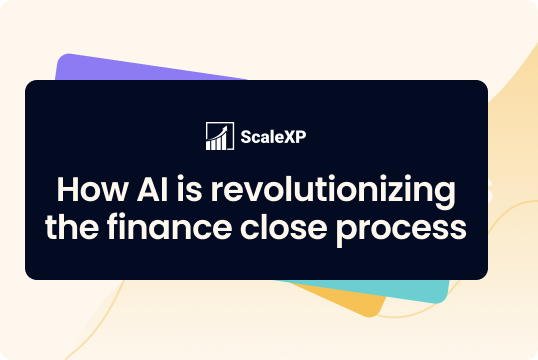For finance teams, the month-end close has long been a necessary evil — a stressful, manual, and error-prone ritual that consumes valuable time and energy. But artificial intelligence (AI) is fundamentally reshaping this process. From automated journal entries to predictive accruals and real-time reconciliations, AI is eliminating bottlenecks and enabling what many are calling the continuous close.
A new era: Continuous accounting
In traditional accounting, the close is a fixed point — a scramble at the end of the month to reconcile accounts, post journals, and generate reports. But with the rise of AI, this paradigm is shifting. Companies like ScaleXP, Brex, and Redwood are pioneering tools that update financials in real time. These systems use machine learning to process invoices, allocate revenue, and generate journals automatically — significantly accelerating the month-end process.
The result? Finance teams no longer wait until day 10 to see last month’s results. With AI, the books are nearly always up to date.
Why it matters: Speed, accuracy, and strategic insight
AI automation brings three powerful benefits:
- Speed: Automated journal entries and reconciliations can cut the time to close by 50% or more. One Optimus Tech study showed finance teams achieving closes that were 32% faster than before.
- Accuracy: By using historical patterns and live system data, AI reduces errors and flags inconsistencies before they become problems. Predictive accruals, for example, can spot when a supplier bill is missing and prompt a provisional entry — no spreadsheet required.
- Strategic Insight: With routine tasks handled by AI, finance leaders can focus on higher-value work like cash forecasting, margin analysis, or scenario modelling.
From RPA to agentic ai
Early finance automation relied on RPA (Robotic Process Automation) — scripting manual steps. But today’s solutions go further, using agentic AI and co-pilot models that not only automate but intelligently adapt. These systems track close progress, assign tasks, flag delays, and even suggest actions. Tools like Datagrid’s finance co-pilot act as digital controllers, helping manage the full close cycle.
What’s next: From close to command
The endgame is not just a faster close — it’s real-time, autonomous finance. Imagine systems that continuously track performance, flag risks, and suggest corrective actions. We’re not far off.
But challenges remain. Finance leaders must balance automation with control, ensuring auditability and governance. They must also upskill their teams, shifting focus from task execution to oversight and strategic judgement.
How to get started
For finance teams ready to embrace automation, the best first step is to identify one or two high-effort manual tasks in your month-end process — such as deferred revenue journals or cost accruals. Evaluate software platforms that integrate directly with your accounting system and offer AI-driven automation. Start with a pilot implementation, measure the time saved, and build internal confidence before rolling out more broadly. Partnering with vendors who offer onboarding support and integration expertise can make the transition smooth and successful.
Three easy steps for Xero or QuickBooks users to integrate AI
For users of Xero or QuickBooks Online, here are three easy steps to begin automating your month-end close using AI:
- Dext to capture and digitise your invoices and receipts
Dext uses OCR and AI to extract key data from supplier invoices, bills, and receipts, feeding it directly into your accounting software. This removes the need for manual data entry and reduces errors. With real-time capture and categorisation, finance teams have immediate visibility into spend and can ensure everything is recorded accurately from day one. Learn more at dext.com. - ScaleXP to automate complex journal entries
ScaleXP connects directly to Xero or QuickBooks and uses AI to generate month-end journals — including deferred revenue, accruals, and prepayments. The system learns from historical patterns and streamlines even the most complex accounting entries, enabling a faster, more accurate close. Learn more at scalexp.com. - ApprovalMax for automated spend controls ApprovalMax adds a layer of control and approval workflows to your accounting system. With automated routing, budget checks, and audit trails, it helps ensure financial processes stay compliant — without holding up the close. Learn more at approvalmax.com.
The CFO advantage: What top finance teams are doing
The most forward-thinking finance teams aren’t just adopting AI — they’re redesigning their entire close process around it. They’re using AI to operate in near real-time, eliminating manual reconciliations, and shifting focus from backwards-looking reporting to future-focused insights. These teams continuously refine their workflows, use AI to detect anomalies before they escalate, and free up senior staff for strategic projects like scenario planning and board reporting. The result is not just faster closes — it’s better decisions.
Why does this matter? Because today’s CFOs are expected to be more than financial stewards — they must be strategic partners to the CEO, operational leaders, and storytellers to investors. When the numbers are late or error-prone, trust breaks down. But when finance delivers fast, accurate, and insightful data, they earn a seat at the top table. For many CFOs, this is personal: it’s the difference between being seen as a back-office function or a key driver of growth. AI can deliver to CFOs and finance teams the ability to act as a proactive business partner, rather than a backwards-looking, increasingly irrelevant function.
In summary
The month-end close is changing — fast. AI is powering a shift from periodic chaos to predictable, real-time reporting. It’s freeing finance teams to spend more time advising and less time crunching.
The question is no longer whether to automate your close — but how fast you can start.


